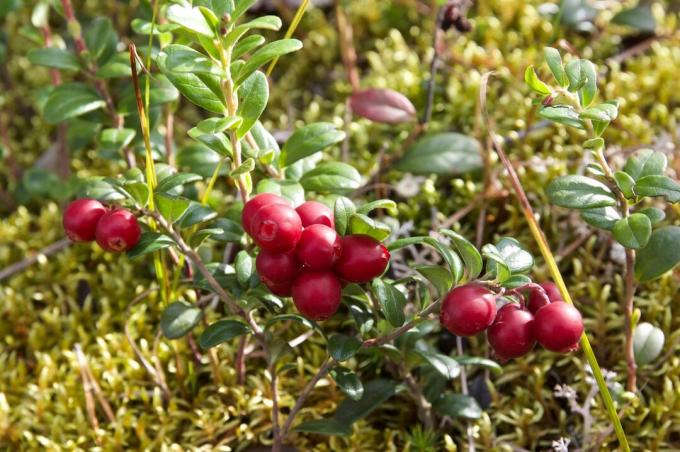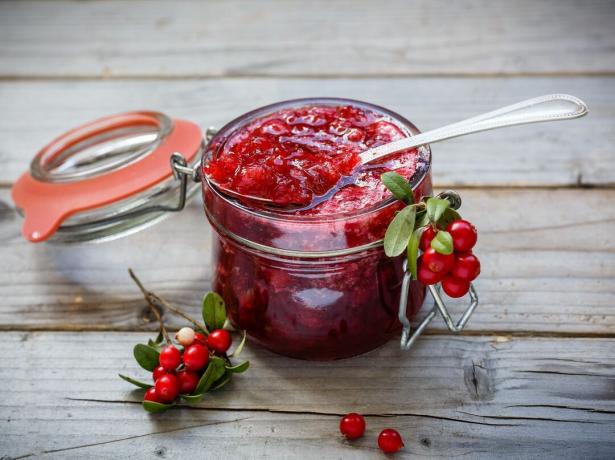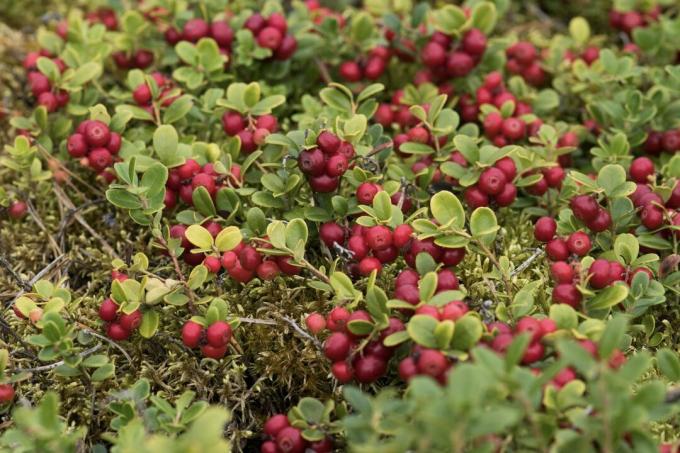Cranberries are known as a healthy snack and delicious side dish in the kitchen. How to grow cranberries yourself, what to look for when harvesting and what the fruits can be used for, learn from this article.

Lingonberries are one of the relatively unknown berry bushes, but they also thrive in our gardens if the demands of the forest dwellers are met. We will introduce you to the most important cranberry varieties and give you tips on growing, harvesting and using cranberries.
"Contents"
- Lingonberries: characteristics and origin
- Differences between lingonberries, currants and cranberries
- Overview of the lingonberry varieties
-
Planting cranberries
- The right cranberry location
- This is how planting works
- Care of the lingonberry: this must be taken into account
- Propagating cranberries: this is how it works
- Harvest and use
Lingonberries: characteristics and origin
The lingonberry (Vaccinium vitis-idaea) is closely related to
blueberries (Vaccinium myrtillus & V.corymbosum) and Cranberries related and is part of the heather family (Ericaceae). It is also known as cranberry, craneberry, cranberry or red bilberry. Due to their wide distribution - from the temperate to the arctic-circumpolar climatic area - there are a large number of names, as well as countless regional names.The wild lingonberry is found in moors, heaths and forests from Northern Europe to Siberia and Japan. Further south in Italy and France, the small shrubs grow up to 2500 m altitude in the Alpine regions, but also in the Caucasus and the Balkans. In commercial cultivation, however, it is not the wild lingonberries, but the higher-yielding Auslese, which are cultivated for the food industry in Central and Northern Europe in particular.
The cranberry bushes reach heights of about 10 to 30 cm and form shoots with few branches. The glossy, dark green leaves of the lingonberry are evergreen and turn reddish from autumn onwards. The leaf shape is reminiscent of that Boxwood (Buxus), which gave the lingonberry the nicknames wild boxwood or wintagruan. It spreads underground via thin rhizomes to cover the ground. The growth of a plant in length is up to 15 cm per year. From May to June the delicate, white to pink colored, bell-shaped lingonberry flowers appear in clusters at the end of the shoot. Up to 20 flowers sit together and develop into bright red fruits 0.5 to 1 cm in size by the time the lingonberries are harvested from August to September. These berries have a floury and juicy consistency and a white pulp with lots of seeds. Lingonberries can be eaten raw and have a tart, sour and aromatic taste.

Differences between lingonberries, currants and cranberries
Some berries look very similar - like cranberries, lingonberries and currants. We explain whether cranberries are also cranberries and how you can easily distinguish all three berries.
Red currants (Ribes rubrum) are only roughly similar to the cranberries because, unlike the latter, they are translucent and have a dried-up calyx residue as a black knob at the lower end of the currant. As the name suggests, they ripen around Midsummer Day, i.e. at the end of June - at this time the lingonberries are still in bloom. Only in autumn do the berries of the evergreen cranberry plants glow on the bush until the next spring. The currant bush, on the other hand, is much larger and woodier, and bare in winter.
This is how currants can be distinguished from cranberries:
- Transparent fruits with black knobs at the bottom
- Ripening time: end of June
- Larger and woodier shrub that has no leaves in winter
Cranberries (Vaccinium macrocarpon) are not cranberries, although they look very similar outwardly, but form a separate species within the genus Vaccinium. The term “cultivated lingonberry” for cranberries is incorrect, but for the sake of simplicity it is often found in grocery stores. In contrast to lingonberries, the cranberry bush forms long, creeping shoots that can spread quickly above ground. On the one hand, the fruits of the lingonberries are significantly smaller than the 2 cm large cranberries and are lighter in color. On the other hand, cranberries sit together at the end of the shoot, while cranberries are formed individually and along the entire shoot. If you have seen both plants and the fruits once, that's the one Difference Between Cranberry and Lingonberry but easy to see and remember.
This is how you can distinguish cranberries from lingonberries:
- Long, creeping shoots
- Smaller fruits with a lighter color
- Fruits are clustered at the end of the shoot

Overview of the lingonberry varieties
Various varieties were selected from the wild lingonberries: some as ornamental plants, which tend to be Provide little yield and tend to produce sour-tasting berries, sometimes as varieties for commercial ones Cultivation. If you want to harvest cranberries from your own garden, you should opt for the latter. We introduce you to the most important cranberry varieties:
Cranberries as ornamental plants
- "Coral": Lingonberry from 1969 from the Netherlands, which was originally grown as an ornamental shrub because its taste is extremely tart and sour. The medium-sized berries ripen on strongly upright, runners-forming shoots.
- ‘Lirome’ / ‘Fireballs’: Cranberry with slow growth and 20 - 30 cm in height. The flowering period lasts from July to September. The round, red fruits ripen between August and October. Due to their sweetish-sour taste, they are suitable for fresh consumption.
- Vaccinium vitis–idaea subsp. minus: A predominantly arctic subspecies of the lingonberry that is native to Iceland, Greenland, North America and northern Scandinavia. The significantly shorter shoots are only 8 cm long and there are significantly fewer pink-colored flowers on them.
Cranberries for processing
- "Thanksgiving": A very high-yielding variety from Germany from 1978. The mid-early ripening cranberry fruits are rather small to medium-sized, dark red and mildly sour. Therefore, they are also suitable for fresh consumption.
- ‘Harvest blessing’: German-bred lingonberries with up to 1 cm large, light red fruits with good yield and later ripening in September. The leaves of this variety are unusually large.
- ‘Red Pearl’: Cranberry variety from the Netherlands from 1982 with 1 cm large, light red fruits, which already bring a rich harvest in August. The variety grows to about 20-30 cm high and is also suitable for fresh consumption.

Planting cranberries
When growing cranberries in your own garden, the location above all has to be right. We explain the requirements and give tips on planting time, spacing and procedure.
The right cranberry location
The ideal location for lingonberries is sunny to partially shaded on sandy-humic or peaty, fresh to wet, rather nutrient-poor soils. Lingonberries are adapted to extremely damp surfaces. They can withstand both waterlogging and drought quite well and will also grow on the poorest soils. The ideal pH value of the substrate is between 4 and 5 in an acidic environment. With neutral or even alkaline, higher pH values, yellow discolouration (chlorosis) occurs and the lingonberry plant later dies.
Lingonberries can be planted in planters or in beds, but please note that naturally calcareous soils with acidic material not suitable even with intensive soil improvement are. On slightly acidic or neutral soils, the cranberries can best be grown in a bog bed with other bog plants such as hydrangeas (Hydrangea), Rhododendrons (rhododendron), Sham berries (Gaultheria procumbens) or Elven flowers (Epimedium) can be set. Creating a bed with acidic soil is worthwhile several times, because the larger the converted area, the better the low pH value will be maintained. In many gardens, the calcareous topsoil has to be removed at a height of 15 to 20 cm before the beds are planted. It is then replaced by a layer of acidic rhododendron soil mixed with sand and acidic materials such as needle litter, bark mulch or grape pomace. You can use the removed soil for hill beds or raised beds, for example.
If you don't have space for a large-scale redesign of a bed, you can simply cultivate cranberries in pots and tubs. More tips for preparing beds and the ideal composition of the Earth for blueberries, Cranberries and Co. can be found in our special article. The lingonberry is hardy to at least -22 ° C and does not need a sheltered place or extra winter protection.

tip: Promoting soil life with a soil fertilizer - like ours Plantura organic soil activator - can also improve the location for the rather undemanding cranberries without endangering the healthy growth of the heather plant with too many nutrients. Soil fertilizers mainly contain organic carbon from plant raw materials, which nourishes the soil and is available for the build-up of humus.
This is how planting works
The best time to plant cranberries is in late autumn, from October to late November. At the beginning of the cold season, the need for water and growth decrease sharply, the plants are in a dormant phase. After planting, only roots develop; the shrub does not sprout fresh leaves until spring. Alternatively, it can be planted in early spring before the shoots sprout again. When planting in spring, especially in summer, regular watering is required, as the shrubs that have not yet grown quickly suffer from a lack of water.
tip: There are differences in the choice of plants, depending on the situation, how the cranberry plant was propagated. Plants that are propagated by vegetation, such as cuttings, form fewer runners, which makes it easier for the stand to remain “tidy”. Plants that are propagated generatively and grown from seeds have a greater tendency to creep and bloom and also bear fruit much later than vegetatively propagated plants.
Lingonberries can be planted together in rows or to cover the ground. There should be a distance of 25 to 40 cm between the plants. There are six to eight plants per square meter that will completely cover the ground after a few years. Place your cranberry plants in the prepared acidic soil, press lightly all around and then water to wash the substrate to the roots.
tip: Apply a protective mulch layer of finely chopped tree bark or sawdust around the plants. On the one hand, this prevents weeds from growing, on the other hand, it reduces evaporation and helps to keep the soil acidic. Compensatory fertilization is necessary here in order to replenish the nitrogen bound by the decomposition of the mulch - for example with a little soil activator. It is spread directly below the mulch and not incorporated.

Summary: planting cranberries
- Location: sun to partial shade
- Soil: sandy-humic or peaty, fresh to wet, rather poor in nutrients
- Cultivation in beds or pots
- Planting time: October - late November
- Plant spacing: 25 - 40 cm
Care of the lingonberry: this must be taken into account
Weed control is particularly important with cranberries because they are weak and quickly overgrown. Therefore, weed control is one of the most important maintenance measures.
Fertilization is seldom necessary for cranberries, they also get along well on poor soils. In very poor locations, the lingonberries may not show any symptoms of deficiency, but grow very slowly and hardly produce any fruit. Organic fertilization should help here, for example with an organic liquid fertilizer like ours Plantura organic flower & balcony fertilizer or with an organic fertilizer granulate with a long-term effect. The former is simply added to the irrigation water and rinsed directly to the roots of the plants when watering. Pruning measures on the small crownberry should be done carefully, only damaged or old shoots are thinned out.
Propagating cranberries: this is how it works
Cranberries can be propagated easily and quickly using cuttings, runners or seeds. For the propagation of cuttings, cut off annual shoots about 5 cm long in early summer, remove the leaves down to the tip and stick them in a substrate mixture of sand and acidic Potting soil. Until the rooting takes place after a few weeks, the cuttings must always be kept moist before they are moved to their final location.
Most lingonberry varieties form runners through their rhizomes, which can be easily cut and moved.
Propagation using cranberry seeds is also possible, but the seedlings need several years before they bloom and produce fruit. In addition, their properties differ from those of the mother plant.

Harvest and use
The lingonberry harvest season begins in August and can last until October as the berries ripen one after the other.
If the red fruits are not picked, they will remain on the bush through the winter. Numerous birds, mammals and insects enjoy the vitamin-rich delicacy. A lingonberry comb makes harvesting the small fruits a lot easier - this way, usable quantities are quickly collected. The berries can be stored very well even after the harvest and can be kept fresh for several months at low temperatures. Cranberries can be eaten raw, but for most of them they taste far too sour. Therefore, the red berries are mostly enjoyed processed.
Many people know cranberries in the form of compote as an accompaniment to game dishes or camembert. Lingonberry jam works without any gelling agent in the sugar, as the fruits themselves contain so much pectin that the cranberries thicken when they are boiled down. They are also processed into cranberry juice, pulp, brandy or in baked goods. Dried berries can be stored for years in a cool and dark place. The healthy ingredients of cranberries are made up of vitamin C (10 to 20 mg per 100 g), vitamin B, Provitamin A, tannins, organic acids and some minerals such as calcium and magnesium combined.
Cranberry leaf tea is also brewed from the leaves to relieve cold symptoms, rheumatism and urinary tract diseases.
A diverse berry snack garden with currants, blueberries and Co is on the wish list for many garden owners. We provide the best berries for your garden before.
